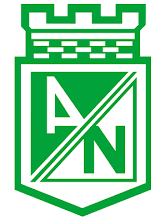Deborah Jacobs went from helping build Seattle's state-of-the-art Central Library to visiting libraries overseas with no heat or running water and budgets as low as $30 a month.
In her first year on the job at the Gates Foundation, she has directed an expanding program called the Global Libraries Initiative, which aims to improve free access to computers and the Internet in public libraries.
Today she is presenting a $1 million prize to a foundation in Medellín, Colombia, for its innovative use of technology in libraries to promote community development.
After more than a decade as City Librarian in Seattle, Deborah Jacobs now manages the global libraries program at the Gates Foundation.
In her travels over the past year Jacobs said she has seen "absolute heroism and commitment to what libraries can do," in places where "librarians are having to close the door to go across fields to their house to get warm water or go to the toilet or wash their hands."
"A million dollars feels like a lot of money to a library system," she said.
The Fundación Empresas Públicas de Medellín, or EPM Foundation, won the Gates 2009 Access to Learning Award.
The network of 34 libraries is part of a regional initiative to use technology to increase the transparency of government, create a competitive business environment and improve education. It serves patrons from low-income communities where people have no computers at home.The network includes five library parks throughout the city that serve as cultural centers with educational resources and training programs for how to use computers and the Internet.
The EPM Foundation's efforts have contributed to the revitalization of Colombia's second largest city, Jacobs said, and its work can be a model for other communities.
"As a librarian I really recognize that libraries with computers can open the doors to people, help people feel a sense of inclusion and greater connection with the broader world," she said. It has also made libraries busier than ever.
The number of library visitors in Medellín's network has jumped from 90,000 to more than 500,000 per month, and the program has helped reduce the individual-to-computer ratio from 140:1 in 2005, to 47:1 in 2008, according to the Gates Foundation.
The EPM program will use the Gates award to increase its library network, develop additional training programs and expand its services.
Complete story...
Sunday, August 30, 2009
Medellín: The Comuna 13 District
Once a battleground, Medellin's Comuna 13 now a place of hope.
On October 15, 2002, the residents of Comuna 13 lived in the most dangerous and lawless neighborhood of Medellin, Colombia, caught in the crossfire between heavily-armed rival factions fighting to control this mountainous district of twisting roads and ramshackle homes.
On October 16, 2002, all of that changed.
On that day, 3,000 Colombian soldiers arrived in Comuna 13 to restore order. They were met with violent opposition from gangs and Marxist FARC guerillas, but within 48hours their bloody victory was assured.
At the time, critics asserted that the government action would only lead to an escalation in violence, that order could not be maintained here, and that right-wing paramilitary groups would continue to terrorize the populace. So far, nearly seven years later, those prophecies have not come to pass, largely thanks to the city’s Proyecto Urbano Integral (PUI—Integral Urban Project).
PUI was the brainchild of popular former Medellin mayor Sergio Fajardo, now a candidate for president of Colombia.
“Every reduction in violence, we had to follow immediately—and ‘immediately’ is a key word—with social interventions,” he told Newsweek magazine two years ago.
Four areas of the city, including Comuna 13, were identified as the top priorities for PUI. Carlos Escobar, PUI’s architectural coordinator in Comuna 13, said these were “zones where there was no presence of the state and the quality of life was very low.”
These areas often had little or no infrastructure. The city brought in architects, engineers, social workers, and communication experts to work with the local community to identify needs.
Escobar said the first task for these specialists was to overcome the “mental barrier” of the local population, which had often seen politicians promise improvements in exchange for votes, but never deliver on the promises.
“That’s why sociologists are so important,” he said.
Escobar said local statutes required the involvement of the local community in planning improvements. For example, he said people might say, “We want to create a park in this area.” The people would then be asked questions like, “What are your dreams about a place like this? What do you want to have?”
The specialists draw up plans based on the public input and then present them for review at public meetings. Based on the feedback received, any necessary revisions are made in the plans.
“Even at this stage, the community can say, ‘This is not what we wanted; we need to modify it,” Escobar said.
Once the majority of the community is satisfied with the plans, construction can begin, which provides benefits beyond whatever is being built.
“They want to generate employment, as well,” Escobar said of city officials, “so people from the community can work on the project.”
Once the work is done, the local residents are asked to make a pact with the city -- a promise they will take care of the new addition to their community.
Today, Medellin officials are proud to show off the changes that have come to Comuna 13, as they did earlier this month to a group of five American journalists. Our visit was sponsored by Colombia es Pasion, the organization charged by the national government with improving the country’s image around the world to increase business, including tourism.
Comuna 13 is not a tourist destination, though some people do take the Metro to the San Javier station and then ride the Metrocable. This is one of PUI’s projects, a gondola ski lift without a ski area or skiers. It carries residents from their mountainside homes, some of which are not served by roads, down to the Metro station, parks, and the library. It used to take the people who live at the top of the mountain 40 minutes or more to walk the distance the Metrocable covers in a few minutes.
At the end of the Metrocable line, we were joined for the ride back down by one of those people, a young woman named Melalyn. She had arrived in Medellin in June from northern Colombia.
“I was displaced by drug violence,” she explained through an interpreter. “I came to Medellin looking for a safer place.”
Today, Medellin, once the murder capital of the world, is considered “a safer place,” and the Comuna 13 project has become a model for others to follow.
When they were developing ideas for what to do in Comuna 13, Medellin city officials visited Rio de Janeiro, to study how the Brazilian city was dealing with its notorious favelas.
“Now,” Escobar notes, “the people from Rio come here.”
By Dennis D. Jacobs - August 27
Chicago International Travel Examiner
Thursday, August 20, 2009
Invest In The Future Of Colombia
Discover The Transformation of Colombia.
Why Colombia?
A few reasons to invest in Colombia. These include:
Improved Business Environment: During the past five years, the Colombian economy grew by 4% per year. In 2008, Colombia's GDP registered an increase of 2.5%, a positive growth during global recession.
Human Resources: according to IMD 2008, Colombia is the regional leader for managers and has the second most flexible labor system in Latin America. This according to the World Bank 2008.
Ideal Export Platform: Colombia holds an advantage of having signed trade agreements. This gives companies preferential access to markets that extend to more than 1.2 billion consumers, a circumstance that is only enhanced by the strategic location of Colombia.
Incentives for Investors: Colombia is the country with the second best business environment in Latin America, according to "Doing Business 2009". These incentives include:
Free Trade Zones: the most competitive in Latin America because they offer up to a 50% tax break on sales into the local market. They also can be established in any place in Colombia.
Legal Stability Contracts.
40% tax deduction on the cost of purchased machinery.
Quality of Life: Colombia has three of the top 30 universities in Latin America, 26 schools which give the SAT Test, 19 which are members of the International Baccalaureate Organization (IBO) and more than 45, 18 hole golf courses.
Discover The Transformation of Medellin, Colombia.
Wednesday, August 19, 2009
Colombia: The Happiest Place On Earth

Bienvenidos a Colombia ! !
Move over Disney World... the happiest place on Earth is in Colombia
International Travel Examiner - Dennis D. Jacobs
Somewhere near the bottom of my deceptively potent Mandarino cocktail, I realized that the happiest place on Earth is not in Orlando, Florida, but Chia, Colombia.
More specifically, the happiest place on Earth, at least Friday night, was Andrés Carne de Res. This restaurant/bar/nightclub is a combination of Applebee’s on steroids and your favorite steakhouse on HGH and your favorite dance spot on a six-pack of Red Bull. Outside, there are Christmas lights strung through trees and Moulin Rouge-style windmills. Inside, the décor includes large dangling lighted hearts, butterflies, traffic signs, clocks, posters, video screens, festive party decorations, mannequins hanging from rafters, musical instruments, and… well, you get the idea.
Andrés Carne de Res is beyond kitschy. It’s a chaotic cacophony of cultural clutter.
This is not a calculated production originating from a major corporation’s market research. It sprang from simple and humble origins. When artist Andrés Jaramillo opened the restaurant in 1983 there were just 40 seats. Now, a nice Saturday night might attract 2,000 customers or more. There are hundreds of employees and millions of dollars in yearly sales.
Friday night, the place was packed, but Saturday night is usually the busiest night at Andrés Carne de Res. It’s not uncommon for there to be a long line of people waiting to get in.
How did Jaramillo’s creation become so popular?
“A lot of people here in Colombia think he made a pact with the devil,” said Carlos, one of the Bogota residents who made the half-hour trip to Chia with our group of journalists. “That made him even more famous.”
Colombian author Gabriel Garcia Marquez, winner of the 1982 Nobel Prize for literature, is among the many Latin American celebrities who have visited Andrés Carne de Res. As we danced to “Me Enamora,” the pop hit by Colombian rocker Juanes, our hostess, Stephany Romero, pointed out a Colombian TV star. By that time, though, I had pretty much finished my Mandarino, so I can’t begin to tell you who he was.
You don’t have to drink alcohol to enjoy Andrés Carne de Res. On Sundays, the restaurant is more of a family place. And the steaks, which Carlos said are prepared in an Argentinean fashion, are thick and savory. Another must-try item is the surprisingly addictive plantain pizza. The menu is on a paper roller encased in a box that you crank to view the seemingly endless list of options.
Before we arrived, Carlos explained that a visit to Andrés Carne de Res is “like going into a theater,” which he attributed to Jaramillo’s personality.
“He was one of the most famous characters here in Colombia,” Carlos added. “He’s very eclectic.
Entertainers wander through the crowds of people, performing and interacting. A couple of 1920s-style flappers visited our table to help wish one of us a happy birthday.
As the enterprise continues to grow, so does the collection of decorations. Part of the staff is dedicated to finding new stuff to add on a continual basis.
The music is loud and the crowds and clutter add to the confused jumble of the place, so Andrés Carne de Res is not for everyone. Then again, neither is Disney World.
COLOMBIA IS PASSION
A great series of articles on Colombia by: Dennis D. Jacobs.
Wednesday, August 12, 2009
The Festival of Flowers in Medellin

Orchids, Birds and Flowers in Medellin, Colombia
August 10, Chicago International Travel Examiner Dennis D. Jacobs
Slowly but surely, like a germinating seed, Medellin, Colombia – once the murder capital of the world – is becoming the flower capital of the world.
Every year at the beginning of August, this city of 2.4 million people puts on a huge celebration called Feria de las Flores (Festival of Flowers). This year’s festival stretched from July 31 to August 9 and featured a wide array of events ranging from antique automobile displays to concerts and theatrical performances.
The biggest event of the festival is the parade which takes place on Friday, a national holiday in Colombia. A highlight of the parade is the procession of silliteros – local flower growers who march carrying massive flower arrangements on their backs.
Another major attraction of the festival is the Orquídeas, Pájaros y Flores (Orchids, Birds and Flowers) show held at the Medellin botanical garden in a facility called the Orquideorama. As part of a group of journalists touring the country as guests of Colombian tourism officials, I got a behind-the-scenes look as 100 workers prepared for last Wednesday night’s opening of the show.
Although orchids are the stars of this show, put on by the Sociedad Colombiana de Orquideología (Colombian Society of Orchidology), many other flowers are represented, including carnations, roses, delphiniums, and bird of paradise.
Speaking of birds, scattered amid the displays are cages holding canaries, parakeets, and larks whose colors rival those produced by the flowers.
The show’s imaginative displays attract many visitors and there are sometimes long lines to get into the facility, the jewel of the refurbished nine-acre botanical gardens.
In addition to Medellin residents, each year the flower festival attracts 300,000 visitors from other parts of Colombia and about 10,000 from outside the country.
As word gets out that Medellin is no longer a dangerous place (local officials proudly point out that the violent crime rate in the city is lower than many American cities, including Washington, D.C.), those numbers are likely to continue to grow… slowly but surely.
The Silleteros Parade: Hop on a chair and get carried away in Medellin
In Spanish, a silleta is a small chair. The man carrying a silleta on his back is a silletero.
The strong silleteros in the area around Medellin, Colombia – legs hardened by tramping up and down the Andes Mountains – used to convey travelers in those chairs. They also carried produce down from the mountains, including flowers.
Over time, the chairs grew more and more elaborate. Some included leafy canopies to protect the traveler from sun and rain. Those used to convey produce also grew in size to accommodate more cargo.
This tradition lives on today in the Desfile de Silleteros (Silleteros Parade), the biggest and longest-running event in Medellin’s annual Feria de las Flores (Flower Festival) that takes place annually the first week of August. The first Silleteros Parade was held in 1957. It has grown over the years to include other participants, such as bands and dancers, but the silleteros are still the stars of the show. About 500 take part in the event each year.
The silletas are judged prior to the start of the parade in a variety of categories, from traditional silletas like those used by farmers to sell flowers outside churches on Sundays to the monumental silletas. The latter may stand over 12 feet tall and weigh upwards of 220 pounds!
Discover The Transformation of Medellin, Colombia (click here.)
Thursday, August 6, 2009
Juan Valdez: The Most Famous Colombian

The story of the most famous Colombian of them all -- Juan Valdez
By Dennis D. Jacobs - Chicago International Travel Examiner
I’m going to let you in on a little secret.
Juan Valdez, the one Colombian most Americans can probably name, is not a native Colombian.
Shocking, I know.
It turns out Juan was born in New York City in 1960. You probably thought he was older than 49, too. It seems like he should be. After all, we’ve been watching Juan and his faithful mule, Conchita, bringing the coffee beans down from the mountains of Colombia for years and years.
Juan Valdez was not born in a hospital, but in the offices of the DDB ad agency. The “Mad Men” there created Juan for one of their clients, the National Federation of Coffee Growers of Colombia, which was founded in 1927.
The idea behind the ad campaign, which became one of the most successful and long-running in history, was to distinguish coffee made with 100 percent Colombian coffee beans from those using coffee beans from other countries.
From 1960 to 1969, Juan Valdez was portrayed by José Duval, who was not Colombian. He was born in Havana, Cuba and came to the United States at the age of 20 to pursue a career as an opera singer. He appeared in a touring production of “Die Fledermaus” for New York City’s Metropolitan Opera and then branched out into musical theater and movies. He died in 1993 at the age of 72.
From 1970 to 2006, Juan Valdez was portrayed by Carlos Sanchez, who grew up in the Colombian town of Fredonia in the coffee-growing region of Antioquia.
The new Juan Valdez is Carlos Castañeda, a coffee grower from the town of Andes, also in Antioquia.
Although Juan Valdez has helped establish the idea that coffee made from Colombian beans is the best in the world, until recently coffee actually sold in Colombia was not considered very good.

“We had outstanding quality coffee, but we had no idea how to drink it,” explains Harry Sasson, Colombia’s foremost chef.
He says coffee traditionally was free in restaurants and was drip coffee. Also, all the best coffee beans were exported. That is changing, and again Juan Valdez has a role.
Taking a page from Starbuck’s, the National Federation of Coffee Growers of Colombia opened its first Juan Valdez Café in Bogota in 2002. Its success led to its expansion to Medellin, Cali, and other Colombian cities. The first Juan Valdez Café in the United States opened in 2005.
“Juan Valdez is incredible what they’ve done,” says Sasson, who owns and operates five restaurants in Colombia.
Restaurants in Colombia have had to upgrade the quality of the coffee they serve to their customers. Sasson says they’ve brought in Italian technology to create espressos and cappuccinos.
“I buy my coffee for some of my restaurants straight from the farms,” he notes. “We try to get the money for the growers.”
Thanks in no small part to Juan Valdez, Colombia’s coffee growers continue to thrive. Almost 15 percent of the country’s population depends on coffee for their livelihood and there are more than 500,000 coffee growers in the nation.
Discover The Transformation of Medellin, Colombia (click)
Juan Valdez Coffee (click)
Tuesday, August 4, 2009
Feria De Las Flores On YouTube
The first day of La Feria de las Flores in Medellin.
El Combo De La Estella live from Feria de las Flores singing the widely popular song "Me Voy Para Medellin!"
Fondas en la Feria de las Flores.
La Cabalgata, horse parade in La Feria de las Flores, a popular event during the weeklong festivities.
Noche Clásica y Tablados en la Feria de las Flores 2009.
Bienvenidos a Santa Elena entre La Feria de las Flores.
The good people of Santa Elena, the town responsible for some of La Feria de las Flores best Silleteros exhibitions during the parade invite everyone to Santa Elena to learn about the local culture and see how the beautiful flower diplays are put together, but they ask that visitors do not disturb the peace and avoid loud partying in the town of Santa Elena.
Monday, August 3, 2009
First Few Days Of La Feria De Las Flores

All the world is a stage during La Feria de las Flores in Medellin ! ! !

The children in Medellin march down the streets during the parade of silleritos during La Feria de las Flores.

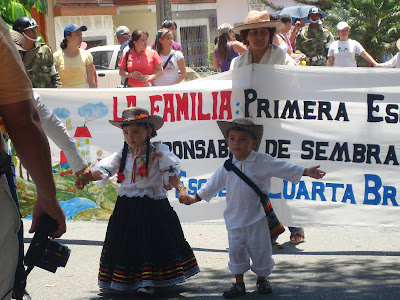.jpg)
Los ninos de la ciudad de Medellin desfilan por las principales calles de la ciudad durante el desfile de silleteritos en La Feria de las Flores.

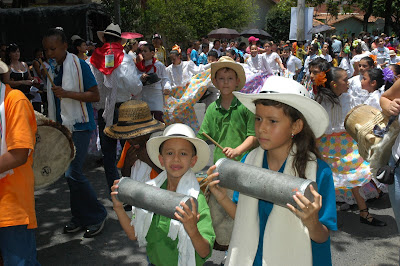.jpg)
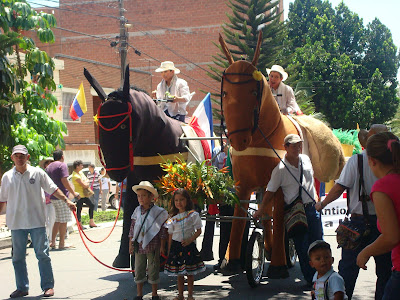.jpg)
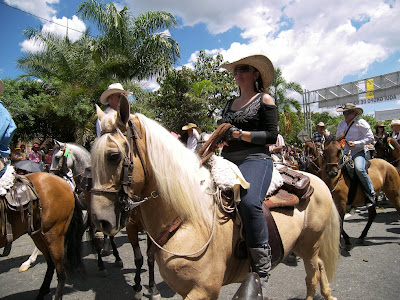.jpg)
The Cabalgata, horse parade is one of the most popular events during La Feria de las Flores. It seems everyone in Medellin loves to ride a horse.

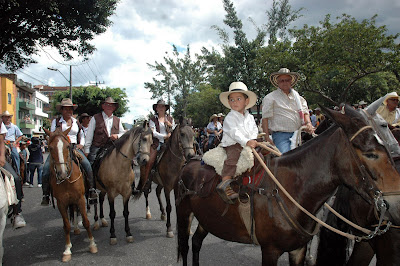.jpg)
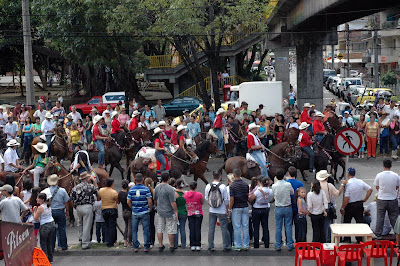.jpg)
Uno de los eventos que más miradas atrae dentro de la Feria de las Flores es la tradicional Cabalgata, el desfile de caballos.
The first few days, "La Feria de las Flores" in Medellin, 2009.
Children Beyond Our Borders in Colombia
There are many children in Colombia who go hungry each day.
UF Student Group Seeks To Help Colombian Kids
By Juliana Jimenez
Pablo could have had anything he wanted for Christmas - toys, clothes, money.
But he had something else in mind.
University of Florida graduate student Angelica Suarez, 25, told 8-year-old Pablo, a boy from the slums of Medellin, Colombia, to ask for whatever he wanted, and his "friends" from UF would do anything to get it for him.
"I want a hug," Pablo said, and Suarez says his answer changed her life.
A year before Suarez met Pablo, when she was vice president at UF's Colombian Student Association, she found she "had a very big problem," she said. "I didn't like throwing parties for no reason."
COLSA was renowned for its parties, which attracted scores of people and raised hundreds of dollars, she said.
So Suarez decided to use this money for a good cause, and Children Beyond Our Borders was born.
Donations has helped to feed many families in Medellin.
CBOB started as a small committee, then developed into a UF student organization. Now, six years later, it is a nongovernmental organization planning its sixth trip to Colombia from Aug. 8-22.
Suarez, founder and now vice president of CBOB, said in her first trip with CBOB she found the inspiration to keep working hard for the organization.
CBOB's first trip was in the summer of 2004. Five UF students took 300 pounds of clothes and 200 pounds of toys to Medellin, Colombia, which they had collected during the school year.
The NGO now carries out two annual projects in Colombia: one to Medellin in August, and another in Cartagena in May.
"I am debating who has more fun, the kids or the volunteers," Suarez said. "The kids teach us more things than we can teach them."
Students who want to volunteer helping children abroad can register with CBOB in November for the May 2010 trip to Cartagena.
With CBOB, students can work in public relations, marketing, program development and grant writing.
The level of involvement depends on the student's enthusiasm, Suarez said.
"We try to see the person's individual skills," she said. "The experience is not only to go outside the country and see places; it also allows you to expand your creativity."
Children Beyond Our Borders
Crossing Borders On The Road is the annual service trip of CBOB. For the past five summers students from the University of Florida and various other universities within the United States have gathered and traveled to Colombia to make a lasting change on the lives of CHILDREN.
During an entire academic year, student volunteers gather monetary and in kind donations such as clothes, hygiene products, school supplies and computers, which are then delivered to the cities in which our service trips take place. Also, CBOB works on different projects to be implemented with fundraised materials during the summer service trips. Before the trip, volunteers prepare, plan, and put together workshops for the children. Some of the topics we teach include Leadership, the Environment, Arts & Music, Self-Esteem, and Peace Education. We truly believe in sharing our knowledge and love with the world. That is why, for these service trips, it is very important that every volunteer contributes to the development of the educational material to be implemented in the trips regardless of their major or experience. This is what ultimately makes our Crossing Borders trips unique and a complete success.
To make a donation or for more information on how to help the children in Colombia visit Children Beyond Our Borders.
Saturday, August 1, 2009
Calle 13 At Parque Norte
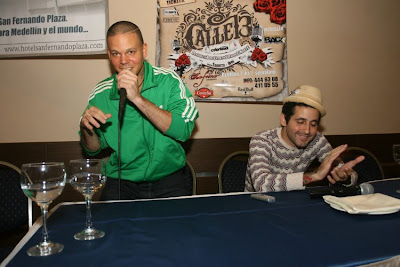
Calle 13, los boricuas de Nueva York en San Fernando Plaza.
Calle 13 arrived in Medellin ahead of “Feria de las Flores” for their show in Parque Norte.
Calle 13, the five-time Latin Grammy Award and Grammy Award-winning Puerto Rican hip hop and alternative group arrive in Medellin, Colombia for a one-night show Saturday before flying off to play in Mexio ahead of their extended trip to Europe.
The rapping is in Spanish; the music is from Puerto Rico, Macedonia and Nigeria; the sensibility is from Mars. Grammy-winning duo Calle 13 have no analogue in U.S. hip-hop: They're pop-savvy hitmakers with globe-trotting tastes and a riotous sense of humor.
Here, they flaunt their cosmopolitanism, collaborating with Mexican rockers Café Tacuba ("No Hay Nadie Como Tu") and spicing their songs with Afro beats, polka and, on "Fiesta de Locos," Balkan brass. Spanish-speakers will love Residente's witty raps, but you don't need to know a word to grasp his message: a plea to bury geographic boundaries under an unstoppable groove.
The duo formed by half-brothers René Pérez Joglar , who calls himself Residente and Eduardo José Cabra Martínez, who calls himself Visitante. Their sister Ileana (aka PG-13) has contributed the female vocals to some of their songs, and so has Residente's mother, Puerto Rican actress Flor Joglar de Gracia.
Atrevete te te (video)
Cumbia De Los Aburridos (video)
Tango del Pecado (video)
Calle 13 plays at the Plaza de Eventos located in Parque Norte.
When: Saturday, August 1st
Time: 8:00pm
General Admission: $63.000
VIP Admission: $103.000
Additional Information: 444 63 00
Subscribe to:
Posts (Atom)















